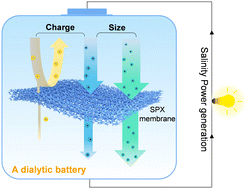A sulfonated ultramicroporous membrane with selective ion transport enables osmotic energy extraction from multiform salt solutions with exceptional efficiency†
Abstract
Osmotic power that can be converted into electricity in membrane-based processes is a sustainable energy source. This concept is, however, limited to salinity differences between seawater and river water, while the efficiency is often restrained by inadequate membrane selectivity. We propose that by confining the transport of ions within the <1 nm sized ion channels, high membrane selectivity can be acquired, thereby improving osmotic power generation and extending the concept to other solutions, e.g. industrial wastewater. This is demonstrated with an intrinsically ultramicroporous sulfonated polyxanthene-based (SPX) membrane. The SPX membrane with negatively charged sub-1 nm channels shows charge-governed ion transport and a strong size effect, which combine to contribute high selectivity. An osmotic power generator with the SPX membrane delivers an efficiency of 38.5% from mixing river water with seawater. The strong size effect also enables power generation from solutions with equimolar concentrations, a conceptually new energy extraction system. Combining concentration and thermal gradients yields a power output of 1.2 W m−2, along with an exceptional efficiency of 48.7%. The results highlight the potential of the proposed membrane for application in energy-harvesting devices and open up unexplored avenues towards diversified forms of osmotic electricity generation.



 Please wait while we load your content...
Please wait while we load your content...